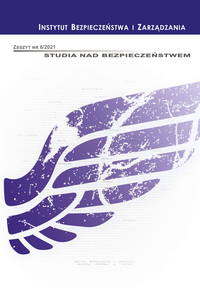Abstract
The aim of this paper is to present and encourage the use of activation methods in conducting classes with students. The article describes one activation technique – Mind Mapping. The author also describes the course of summary classes in the subject of ‘Economic Security’, during which this technique was used. The main objectives of conducting the above mentioned classes using Mind mapping were: 1. To include all students from a given group in the process of summarizing the knowledge of a given subject; 2. To motivate students to independently systematize the content learned during the classes. The author also asked herself the questions: 1. Is it worth combining the so-called traditional forms of teaching with activating methods? Do students like classes with the use of active methods? On the basis of literature review and students’ answers to a survey conducted at the end of classes, it can be definitely confirmed that it is worthwhile incorporating activation methods during classes as they actively engage students in the learning process. The use of activation methods leads to a significant increase in efficiency and improvement of the entire didactic process.
The following research methods are used in this paper: a literature review on the presented topic and a survey questionnaire. The purpose of the literature review is to introduce the reader to the activation methods, their division and the individual steps of creating mind mapping. The purpose of the questionnaire survey among students was to obtain feedback on how to conduct classes with the use of the mind mapping activation method. The article presents a map made by students of the National Security major, as part of the final classes of the course ‘Economic Security’ implemented in the academic year 2018/2019, who prepared a summary of the acquired knowledge using the discussed activation technique.
References
Gola B., Pauluk D., Stosowanie metod aktywizujących przejawem profesjonalizmu nauczyciela akademickiego, https://edukacjaustawicznadoroslych.itee.radom.pl/images/2015/2/03_2_2015.pdf, [access: 04.12.2021].
Pawełczyk M., Nowoczesne metody nauczania w technicznej uczelni wyższej, https://www--arch.polsl.pl/Jednostki/RJO3-KS/Documents/MPawelczyk.pdf, [access: 04.12.2021].
Radomski A., O zastosowaniu map myśli w nauce i edukacji, “Kultura i Historia” 2019, nr 36 (2). Rapacka-Wojtala S., Metody aktywizujące w nauczaniu dorosłych czyli jak sprawić, aby studentom chciało się chcieć, 187_208_Rapacka-Wojtala.pdf (lodz.pl), [access: 04.12.2021].
The Effects of Szewczuk-Stępień M., Adamska M., Efektywność procesu dydaktycznego wykorzystującego metody aktywizujące, Współczesne zarządzanie. Koncepcje i wyzwania, A. Sopińska, A. Modliński (red.), Warszawa 2020.
Mind Mapping Activities on Students’ Motivation, https://digitalcommons. georgiasouthern.edu/cgi/viewcontent.cgi?article=1314&context=ij-sotl, [access: 04.12.2021].
Wnęk-Gozdek J., Formy i metody aktywizowania studentów, Formy i metody aktywizowania studentów, [w:] Współczesne wyzwania dydaktyki szkoły wyższej (up.krakow.pl), [access: 04.12.2021].
Ying Liu,Guoqing Zhao, Guozhen Ma and Yuwei Bo, The Effect of Mind Mapping on Teaching and Learning Meta-Analysis, https://www.researchgate.net/publication/297833919_ The_Effect_of_Mind_Mapping_on_Teaching_and_Learning_A_Meta-Analysis, [access: 04.12.2021].
https://learningscoop.fi/activating-methods-in-classroom/, [access: 04.12.2021].
https://medium.com/cultivate-grow-your-teaching/tips-for-student-activating-teaching-fe72a-e0c8de9, [access: 04.12.2021].
https://www.mindmaps.com/what-is-mind-mapping, [access: 04.12.2021].
https://www.mindmeister.com/blog/why-mind-mapping/, [access: 04.12.2021]. https://www.port.ac.uk/student-life/help-and-advice/study-skills/mind-mapping, [access:04.12.2021].
https://www.queensu.ca/teachingandlearning/modules/active/04_what_is_active_learning.html, [access: 04.12.2021].
https://wyborcza.pl/napamiec/7,139301,16645287,ile-mamy-neuronow-w-mozgu.html?disableRedirects=true, [access: 04.12.2021].

This work is licensed under a Creative Commons Attribution 4.0 International License.
Copyright (c) 2021 Array

